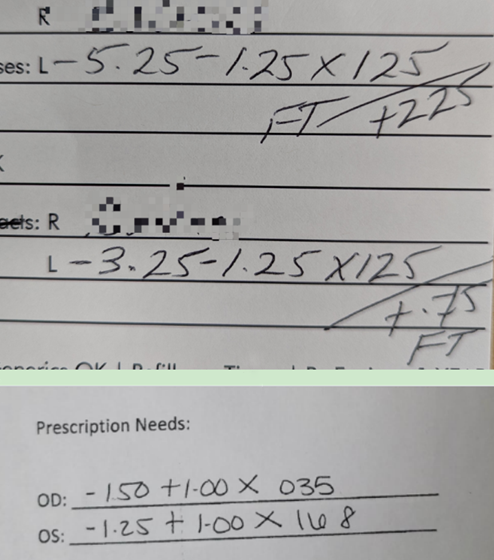After your eye exam, your eye doctor will give you a piece of paper with your eyeglass prescription. They may have mentioned that one of your eyes is weaker than the other, that you’re nearsighted, farsighted or have astigmatism despite explaining that to you, however, the actual prescription they hand you may seem like gibberish and make little sense to the general public at first glance.
What do those terms, numbers and letters all mean on the prescription? You might have noticed those little abbreviated terms on the prescription such as, OD, OS, SPH, and CYL, what do those mean? Here is a brief overview of how to understand your prescription after leaving your eye doctor.



This is what it will look like on our site:

Most state’s laws say that an eyeglass prescription is valid for 2 years, however most states allow for the doctor to adjust this based on their professional judgment. Unless otherwise noted, your Rx is out of date after 2 years.
1. OD, OS, OU
The OD and the OS meanings
Prescriptions are full of little abbreviations of other words, and the first two you need to know to understand your prescription is OD and OS. These abbreviations stand for oculus dexter and oculus sinister respectively, which are the Latin terms for your “right eye” and your “left eye.” if it says OU in replacement of one of the other two abbreviations, this stands for oculus uterque, which stands for “both eye.”
In many prescriptions, particularly eye prescriptions, the Latin terms are the most common route for abbreviations. This usage is similar to the use of A.M. for the morning, the Latin term ante meridies, which means “before midday.” It’s the same use of language that applies to prescriptions; however, there are some prescriptions for contact lenses or medications that may replace these old Latin terms with “RE” and “LE” for the right eye and left eye.
The general organization of these prescriptions is that the right eye’s information will always come before the information on the left eye. This is because this order is the same as the order that the doctor would be checking your eyes generally — starting with the left and moving to the right.
The Other Aspects of Your Prescription
Of course, there are more than just the OD and OS on your prescriptions. What do the other aspects of the prescription mean and refer to?
2. Sphere (SPH)
The SPH indicates the amount of power the lens needs, measured by diopters (D). This abbreviation helps to indicate your prescription needs for your lenses, from nearsightedness to farsightedness. The number that would sit below the SPH heading is prefaced by a ( – ) it indicates that you’re nearsighted, where the ( + ) indicates farsightedness.
The term “sphere” is used as it is to indicate that this correction needed for your eyes is equal in all the meridians of the eye, meaning the eye is “spherical.”
3. Cylinder (CYL)
The cylinder column is to indicate astigmatism. If there is nothing in this column, there is no astigmatism to be worried about, or you don’t need correction for it. It is a “cylinder” because the lens power needed to correct the astigmatism is not spherical. The same ( – ) and ( + ) system is used.
4. Axis
This is defined from the numbers 1 to 180, 90 corresponding to vertical meridian and 180 corresponding to the horizontal meridian and indicates where the cylinder correction should be located.
5. Add or NV-ADD
This indicates the need to add magnifying power to the bottom part of a multifocal lens used when correcting presbyopia. This number is always a “plus” regardless of whether the number is prefaced with the sign.
6. Prism
This is used as a metric to compensate for eye alignment problems. It is the amount of prismatic power needed, measured in prism diopters or “p.d.” This is not commonly used or seen as few prescriptions require it.
7. PD (Pupillary distance)
Pupillary distance, sometimes referred to as pupil distance or just PD, is the distance between the center of each pupil and the bridge of your nose measured in millimeters. PD is essential for crafting prescription glasses because it helps us know where to place the power on your lenses. Without a correct measurement, the prescription power of your lenses will be off-center from your eyes and you won’t be able to see out of your prescription glasses, even if your prescription is otherwise 100% correct.
Binocular PD, sometimes referred to as single PD, is total distance between the center of both pupils.
Monocular PD, sometimes referred to as dual PD, is the measurement of the center of each pupil to the bridge of the nose. To enter monocular PD, click on the Monocular PD tab.
What do I do if my PD is not on my Prescription? Call the doctor’s office. They don’t always write it on your Rx, but they will usually have the number on file. If obtaining your measurement from your optometrist isn’t possible, no worries—you can measure it from home using our special ruler! For more information on measuring your PD, go to https://www.payneglasses.com/pupillary-distance
8. Additional Comments
There is often an area for the doctor to write additional comments or recommendations. This is usually where they would specify NVO (Near Vision Only) or if the Prescription Eyeglasses are to be used for a specific task like music or computer work. Other recommendations written in this section would be to specify the lens material, or lens coatings such as coatings for Anti-Reflective lenses, Photochromic (Light-Responsive) lenses. It may also indicate which type of multi-focal (bifocal or progressive) you should choose.










